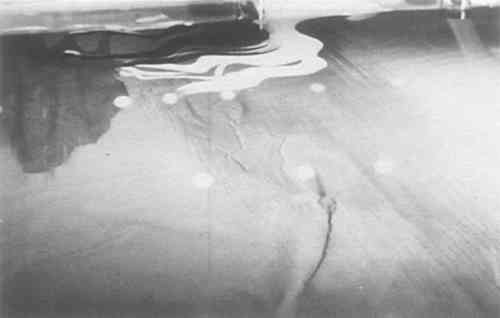TREATMENT AND MOUNTING OF A POSTER ANGLETERRE BY A.M. CASSANDREAntoinette Owen
3 THE ENZYME PROCEDUREREMOVAL OF THE CLOTH BACKING and tenacious starch was easily accomplished on the other three quadrants. The procedure used was as follows: The large tray was placed on the surface of the vacuum hot table and the table was warmed to 39�C. A small amount of water was placed in the tray to conduct the heat. The quadrants, face down on the cushioned support, were placed in the tray. The enzyme solution, warmed to 39�C and with a pH of 7.2, was brushed onto the cloth. A sheet of polyethylene was used to cover the entire tray in order to maintain the temperature. The average length of time for successful enzymatic action was 15 minutes, after which the cloth was usually found to be detached from the paper. Tests with the iodine/potassium iodide solution indicated whether any residual starch remained on the paper. After rinsing the quadrants for � hour in a water bath followed by a second rinse with running water, they were allowed to air dry. The verso was then sprayed with ethanol to deactivate any residual enzyme. The quadrant was then turned face up on the screen and given a water bath (pH 8.5 with the addition of calcium hydroxide solution), again employing the surface of the vacuum hot table to slightly warm the water. It was felt that any residual enzyme or minute amount of starch, as well as paper degradation products, would be encouraged to diffuse from the paper by this warm, alkaline water bath. An interesting observation was made during water washing the quadrants. The sharp creases mentioned earlier remained in the ink and paper during submersion in
All pulp fills and tear repairs were completed before backing. Areas of loss were compensated with rag paper pulp; the entire quadrant was wetted onto mylar during the pulping procedure, the sections to be filled were placed over a light box. Because many areas of loss abutted tears, the tears were aligned and secured verso with small Japanese tissue patches before backing in order to complete the pulping procedure on all losses. |
